Comuna 13 (n.º 13) or San Javier is one of the 16 communes of the city of Medellín, Colombia, with a population of around 160,000.[1] The neighborhood is associated with street art performances, graffiti, bright colors, tours, and an energetic environment that showcases its resilience.[2] Comuna 13 was not always a vibrant community, it has faced violence and insecurity with regards to drug trafficking, paramilitaries, and controversial military operations.[3] It is now a major tourist attraction and a keystone of community tourism in Medellín and has benefitted from investment in infrastructure and social programs.[4]
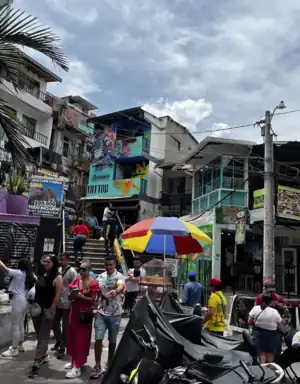
Makeup
Comuna 13 is a neighborhood made up of houses that are typically made out of brick and cement, closely stacked together, and wrapped around the western hills of the city.[5]
Geography and infrastructure
The commune is located to the west of the Central Western Zone of the city, bordered to the north by the Robledo commune, to the east by La América and Laureles-Estadio; to the south by the district of Altavista, and to the west by San Cristóbal and Altavista.[6] It is a neighborhood made up of houses that are typically made out of brick and cement, closely stacked together, and cling to the Andes mountains, sprawling throughout the west hills of the city.[5] Houses are painted vibrant colors but often left unfinished for various reasons such as tax loopholes and lack of resources to finish.[7]
The slopes are found towards the western end, reaching the limit of the urban perimeter. In some sectors, there are very high and steep slopes. Some areas in the commune are characterized as having a high potential risk of natural disasters.[8]
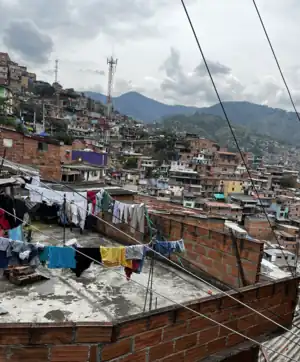
These high risk areas are located in sectors of the neighborhoods Blanquizal, Independencias I, II, and III, Nuevos Conquistadores, Belencito la Colina, Belencito Betania, near the edge of the Ana Díaz ravine, Arenera Monteverde and Barrio La Quiebra, and in the sectors La Divisa and Metropolitano. This danger determined that some neighborhoods and sectors were outside of the Commune's perimeter according to the last agreement mentioned. It has several streams and channels, among others, La Leonarda, La Hueso, La Iguaná, Ana Díaz, La Picacha, La Salada, Los Sauces, La Ladrillera, El Saldo, La Bolillala, La Matea, Los Alcazares, La Mina, Las Peñitas, El Paraíso, la Pradera, La Magdalena, La Pelahueso, Los Sanjones, El Coco and Santa Mónica. In the commune there are some material exploitation farms, among others Triturados Monteverde, Ladrillera el Noral, Arenera el Socorro, Finca Villa Elvira, and Aggregados San Javier.
Role of geography and neighborhood design
Comuna 13's geography has played a role in how criminal actors took advantage of the commune as a strategic location, using elevation to better survey the movement of police and rival groups.[9] The elevation additionally played a historical role, as Comuna 13 began as a farming community.[10]
History
Agriculture
Originally founded by displaced farmers fleeing violence in the rural areas of Colombia, the area was named "Las Granjas", which means "The Farms". The area shifted towards a more residential structure with a housing cooperative in 1946.[10] Immigrants created nearby illegal settlements in the hills, helping shape the neighborhood structure.
Immigration and lack of resources
Waves of migrants from people escaping La Violencia, conflict in Antioquia, and rural fighting between revolutionary guerrilla groups and the Colombian government came to form Comuna 13, although they were often discriminated against as invaders. The neighborhoods in Comuna 13: Las Independencias I, II, III and Nuevos Conquistadores, were built up primarily by immigrants.[10] Immigrants fleeing conflict were vulnerable to being recruited into criminal activity because many had few skills outside of farming and construction, lacked job opportunities, lived in poorly built houses, and drank unsafe water.[10] Many teenagers of the immigrant generations of the 60s and 70s went on to make up the gangs and guerilla groups that were formed in the neighborhood.[11]
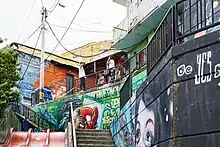
Instability
Comuna 13 suffered for years from violence from Narcos, military operations, and the presence of guerrillas and paramilitaries. Fights between rival groups could make the neighborhood feel like a war zone. The violence from which Comuna 13 suffered made it unsafe to cross neighborhoods and go out at night.[12]
Narcos
Pablo Escobar had control of the neighborhood in the 80s, and a lot of the groups loyal to him came from those gangs, where he would also recruit sicarios. He recruited with the Medellín Cartel, with the purpose of making money from the cocaine trade.[12] Even Hélmer Herrera A.K.A. 'Pacho', a rival of Escobar would also recruit in the area.[12] Violence was common between rival gangs, especially after the death of Escobar with fighting between split up groups.[12]
Paramilitaries and guerilla groups
The guerilla groups FARC, and the National Liberation Army (ELN) had a presence in the commune, occupying various parts of the neighborhood, and implementing various forms of control.[13] The Comandos Armados del Pueblo (CAP) were a paramilitary group that had a lot of strength in Comuna 13 and was like the other left-wing groups in that they were against the rule of the state.[14] They were often seen as a group that would fill the role of the government in fighting other delinquent gangs and groups and improving infrastructure.[14] The guerilla warfare groups were also known to act more openly in contrast to the secretive paramilitaries.[15] When paramilitaries took over in Comuna 13, they instilled their own rule of law, taxing shops, banning gatherings, and recruiting teenagers from struggling families. They had full access to tax and control the funds of people merchants and people delivering or transferring products.[13] Mass graves were discovered near Comuna 13, and they are attributed to the silent killings by paramilitary groups.[15]
Operation Mariscal
Operation Mariscal was a 12-hour operation that began on May 21, 2002, at 3 AM.[16] The military and the police combined in an operation into the neighborhood, sending in tanks, squadrons, and helicopters, with an estimated 100s of personnel going into the neighborhood, attempting to combat the guerrilla militant groups in the neighborhood. 35 people were left injured, with 15 dead, including minors.[17] The people of the neighborhood waved white flags to try and get the operation to stop and they were harassed with the military upholding that the action favored the guerilla militants.[17]
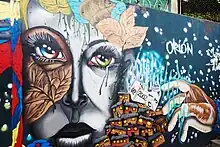
Operation Orion
Operation Orion aimed to finish with the presence of paramilitaries in Comuna 13. Launched under the newly elected President Álvaro Uribe, it was a two-day military offensive that came on October 16, 2002, and involved the use of helicopters, tanks, and automatic weapons.[18] Within the time period of the Colombian armed conflict, the operation was the most extensive action campaign in urban Colombian territory.[19] It targeted members of the ELN, FARC, and the CAP.[19] The operation is controversial as critics and reports, along with witnesses have held that the government targeted civilians. Hundreds of suspected militia fighters were detained, and 20 victims of kidnapping were freed.[15] Operation Orion was successful in driving away the guerrilla militia fighters. After the operation, there was a period of disappearances, with various local stories of kidnappings after paramilitaries entered the zone. Allegations against a government collaboration with the paramilitary groups have been alleged and reinforced by CIA findings.[20] The Justice and Peace Tribunal specifically investigated Uribe for promoting and supporting paramilitary groups.[19] The operation has been condemned by International Courts.[21] The community continues to remember the operation, denouncing the lack of accountability from the government.[19]
Recovery
With community investing in social and educational programs, along with infrastructure, Comuna 13 was able to transform.[22]
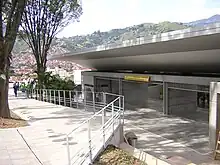
Investment
The Medellín Model was championed by Mayor Sergio Fajardo and also Mayor Luís Pérez. With the social urbanism philosophy, which focuses on communities that have been left behind, the city of Medellín was able to rebrand against the violence with which it was previously associated.[23] Psychologists and NGOs reviewed funding for work in the community. Libraries, parks, community spaces, and schools were built in poorer neighborhoods such as Comuna 13. Childcare programs and support services for victims of domestic violence were set up.[20] Two Metrocable systems and an escalator were erected as well.[23]
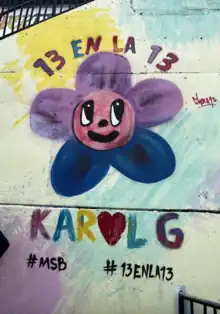
Cable car system
In terms of infrastructure, escalators and two MetroCable lines were able to connect the isolated community to the city center with access to the subway network.[24] The MetroCable has been deemed essential in reducing social exclusion, where a person cannot fully engage in society.[25] The gondola has been credited with connecting neighborhoods and allowing people to find additional employment opportunities, ones which can also lie outside of their immediate neighborhoods.[25]
Art
Members of the Comuna 13 have been able to express themselves and share stories through art. From poetry to graffiti to gardens, the diverse forms of artistic expression are everywhere to be found. Colorful murals with depictions of community figures, past violence, and neighborhood injustices can be seen throughout the neighborhood.[26] One of the most recognized graffiti artists coming out of the neighborhood is Chota 13.[27] Hip-hop and break dance performances are common in the streets.[28] Poets, singers, and rappers tell stories and use their platforms to address social issues in the community. Events are held in public spaces with discussions and speeches.[20]

Community projects
Community advocacy in the face of violence began with action from the people of Comuna 13.[13] Marches and symbollic actions such as waving and hanging up white flags, sheets, and handkerchiefs were used.[13] Additionally, documenting violence and testimonies on line played a role in the advocacy, along with the staging of sit-ins.[13] Community centers like the hip-hop based Casa Kolacho were formed with the goal of getting youth out of the way of violence. The idea behind Casa Kolacho is to be louder than bullets.[28] Casa Kolacho also runs Grafitours, which address the history, politics, and art of Comuna 13.[2]
Tourism
Casa Kolacho as well as other programs run locally-led graffiti tours of the neighborhood. Comuna 13 is one of the most visited tourist sites in all of Medellín. Tourists come from all over the world to see the story of resilience that Comuna 13 provides.[2] Stands fueled by the flow of tourism line the streets selling art, merchandise, accessories, food, drinks, and clothes.[29]
Residents of the neighborhoods Plan del Che, Independencias I, II, and III live among the tourism sector, as these are the main areas of tourism in Comuna 13.[30] It can get up to 6,000 visitors in a day on weekends, and it is one of the most, if not the most, visited areas of all of Medellín.[30]
References
- ↑ Thompson, David P. (January 1996). "Pablo Escobar, Drug Baron: His surrender, imprisonment, and escape". Studies in Conflict & Terrorism. 19 (1): 55–91. doi:10.1080/10576109608435996.
- 1 2 3 Ramirez Suarez, Yenny Carolina (25 May 2023). "Divergent citizenships: Social urbanism and hip hop collectives in Comuna 13 (Medellin - Colombia)". Environment and Planning C: Politics and Space: 239965442311778. doi:10.1177/23996544231177823. S2CID 258939088.
- ↑ Translated by Content Engine LLC. The Problems That Tourism Is Causing in Medellín’s Comuna 13. CE Noticias Financieras. English ed. Miami: ContentEngine LLC, a Florida limited liability company, 2021.
- ↑ "Things to do in Comuna 13". Get Your Guide. 2008. Retrieved November 9, 2023.
- 1 2 Kochhar, Rishabh (7 March 2020). "Notes from Comuna 13". The Hindu.
- ↑ "Comunas e corregimientos de Medellín". Research Gate. 2009. Retrieved November 9, 2023.
- ↑ Moore, Adam; Eiró, Flávio; Koster, Martijn (November 2022). "Illegal Housing in Medellín: Autoconstruction and the Materiality of Hope". Latin American Politics and Society. 64 (4): 94–118. doi:10.1017/lap.2022.31. S2CID 253066273.
- ↑ Owen-Burge, Charlotte (2023-09-21). "The Medellín Project: A climate insurance success story". Climate Champions. Retrieved 2023-11-10.
- ↑ Pachico, Elyssa (2011-05-13). "Medellin's Turbulent Comuna 13". InSight Crime. Retrieved 2023-11-09.
- 1 2 3 4 DayTrips, Medellin (2018-04-06). "Comuna 13: What Happened there? Learn the Real Story in Our Article". Medellin Day Trips. Retrieved 2023-10-15.
- ↑ "Comuna 13: Displacement, conflict and hip-hop - COMPAS". COMPAS - Migration research at the University of Oxford. 2022-01-11. Retrieved 2023-11-10.
- 1 2 3 4 "Commune 13, the cradle of sicarios of Pablo Escobar who fails to escape his spiral of violence". CE Noticias Financieras. 16 April 2021. ProQuest 2513978871.
- 1 2 3 4 5 Alzate, Mary Luz (November 2012). "Acciones colectivas frente a la violencia. Disquisiciones a partir de un estudio de casos: Comuna 13 de Medellín (Colombia)". Universidad Complutense de Madrid. 18 (2).
- 1 2 "La toma a sangre y fuego de la Comuna 13 de Medellín | www.arcoiris.com.co 1" (in Spanish). 2013-01-25. Retrieved 2023-10-15.
- 1 2 3 Rozema, Ralph (August 2008). "Urban DDR-processes: paramilitaries and criminal networks in Medellín, Colombia". Journal of Latin American Studies. 40 (3): 423–452. doi:10.1017/s0022216x08004392.
- ↑ Corredor Rodríguez, Silvia (2022-05-20). "Operación Mariscal: todos los 21 de mayo la Comuna 13 se viste de blanco". ELESPECTADOR.COM (in Spanish). Retrieved 2023-10-15.
- 1 2 Rojas-Páez, Gustavo (23 December 2018). "Narratives from the margins of the state: resisting the politics of exceptionality in the Comuna 13". Oñati Socio-legal Series. 8 (6): 901–924. doi:10.35295/osls.iisl/0000-0000-0000-0972. S2CID 149545889.
- ↑ Pbicolombia (2017-01-10). "Operation Orion". PBI Colombia (English). Retrieved 2023-11-09.
- 1 2 3 4 "Uribe again defended the military intervention in Medellin's Comuna 13: 'Today tourists are visiting it'". CE Noticias Financieras. 30 December 2021. ProQuest 2615612286.
- 1 2 3 Young, Alexandra (2 October 2019). "Creative Resistance in Medellín's Changing Public Space: Medellín's flagship public space interventions fall short of remedying structural problems, but for local residents in Comuna 13, the city's changes offer a platform to advance their struggles for social justice in creative ways". NACLA Report on the Americas. 51 (4): 341–347. doi:10.1080/10714839.2019.1692950. S2CID 212776435.
- ↑ Yagoub, Mimi (January 11, 2017). "Intl Court Condemns Colombia for Bloody 2002 Military Operation". www.google.com. Retrieved 2023-10-15.
- ↑ Naef, Patrick (14 October 2020). "Resilience as a City Brand: The Cases of the Comuna 13 and Moravia in Medellin, Colombia". Sustainability. 12 (20): 8469. doi:10.3390/su12208469.
- 1 2 Drummond, Holli; Dizgun, John; Keeling, David J. (December 2012). "Medellín: A City Reborn?". Focus on Geography. 55 (4): 146–154. doi:10.1111/foge.12005. ProQuest 1319834578.
- ↑ Cunniff, Amy (14 May 2020). "Connecting Classes in Medellín: The Gondola and the Escalator". MUNDI. 1 (1).
- 1 2 Zapata Cordoba, Diego; Stanley, John; Stanley, Janet Robin (13 October 2014). "Reducing Social Exclusion in Highly Disadvantaged Districts in Medellín, Colombia, through the Provision of a Cable-Car". Social Inclusion. 2 (4): 1–13. doi:10.17645/si.v2i4.127.
- ↑ Álvarez Domínguez, Mónica Enriqueta; Trachana, Angelique (6 September 2022). "Arte y Cultura en procesos de transformación de entornos conflictivos. La Comuna 13 de Medellín". On the W@terfront. 64 (8): 3–71. doi:10.1344/waterfront2022.64.8.01. S2CID 252256250.
- ↑ "Chota 13, the art that vindicates the Comuna 13 of Medellín". CE Noticias Financieras. 26 September 2023. ProQuest 2869588053.
- 1 2 Feixa, Carles; Márquez, Fulvia; Hansen, Nele; Castaño, Jeison (30 August 2022). "El hiphop como forma de resistencia frente al juvenicidio: la experiencia de Casa Kolacho". Revista Latinoamericana de Ciencias Sociales, Niñez y Juventud. 20 (3): 1–36. doi:10.11600/rlcsnj.20.3.5550. hdl:10230/54348. S2CID 251984716.
- ↑ "Colombia". Growing With Leala. 2021-04-05. Retrieved 2023-11-10.
- 1 2 "Tourism continues to give life and sustenance to Comuna 13". CE Noticias Financieras. 1 December 2021. ProQuest 2605604758.
Further reading
- "Medellín's Comuna 13: Transforming the Past with Plenty of Paint." The City Paper Bogotá. Accessed October 1, 2023. URL: https://thecitypaperbogota.com/travel/medellins-comuna-13-transforming-the-past-with-plenty-of-paint/
- Cook, Philip; Mack, Elaina; Manrique, Manuel (2017). "Protecting young children from violence in Colombia: Linking caregiver empathy with community child rights indicators as a pathway for peace in Medellin's Comuna 13". Peace and Conflict: Journal of Peace Psychology. 23 (1): 38–45. doi:10.1037/pac0000194.
- Zuluaga, Mary Luz Alzate (2010). "Collective actions in the face of violence. Disquisitions based on a case study: Comuna 13 in Medellín (Colombia)". Frontera Norte. 22 (44): 161–184. doi:10.17428/rfn.v22i44.855.
- Translated by Content Engine LLC. Chota 13, the Art That Vindicates the Comuna 13 of Medellín. CE Noticias Financieras. English ed. Miami: ContentEngine LLC, a Florida limited liability company, 2023.
- Sánchez Medina, Luz Amparo. “Meanings and Practices of Non-Violence: Lessons Learned in the Midst of the Urban War in Comuna 13, Medellín.” In Community-Based Urban Violence Prevention, 150–163. Bielefeld: transcript Verlag, 2014.
- Translated by ContentEngine LLC. The Creativity Applied to Comuna 13 of Medellín. CE Noticias Financieras. English ed. Miami: ContentEngine LLC, a Florida limited liability company, 2019.
- "Perfil Demográfico por Barrio Comuna 13 San Javier." Medellín Government, 2020, https://www.medellin.gov.co/irj/go/km/docs/pccdesign/SubportaldelCiudadano_2/PlandeDesarrollo_0_17/IndicadoresyEstadsticas/Shared%20Content/Documentos/ProyeccionPoblacion2016-2020/Perfil%20Demográfico%20Barrios%202016%20–%202020%20Comuna_13_San%20Javier.pdf.
- Milo Colombia. "Comuna 13: El símbolo de la transformación de Medellín." February 28, 2020. https://www.mieocolombia.com/comuna-13-simbolo-de-transformacion/#:~:text=La%20comuna%2013%20fue%20habitada,acceso%20y%20sus%20múltiples%20callejones
- Pedraza-Pacheco, Flor Adriana; Santana-Murcia, Andrés Rodrigo (July 2021). "Comuna 13 estudio de caso: la historia relatada en las paredes como estrategia de emprendimiento social". Revista de Arquitectura. 23 (2). doi:10.14718/RevArq.2021.4102. S2CID 237814827.
- "La huella invisible de la guerra: desplazamiento forzado en la Comuna 13". 28 January 2016. hdl:20.500.11788/1026.
{{cite journal}}: Cite journal requires|journal=(help) - López-Mera, Silvio Fernando; Quintero-Rendón, David Eduardo (25 April 2019). "Impactos iniciales de la financiación de la educación superior con recursos del presupuesto participativo: evidencia para Medellín" [Initial impacts of financing higher education with participatory budget resources: evidence for Medellín]. Sociedad y Economía (in Spanish) (37): 131–165. doi:10.25100/sye.v0i37.7826. S2CID 203263339. Gale A600665295 ProQuest 2237780833.
- Fierst, Sonya (2013). "El Presupuesto Participativo en el contexto de los jóvenes de la Comuna 13 de Medellín". Analecta Política. 3 (4). Gale A459000857 ProQuest 1327279068.
- Teran Serna, Jose Enrique; Martínez, Angely; Torres Riascos, Ángel Celio (15 September 2017). "Impactos socioespaciales de la violencia en Colombia: análisis de la distribución, localización y evolución de los grupos paramilitares en Medellín y Montería del 2002 al 2008". Razón Crítica (3). doi:10.21789/25007807.1241.
- Rozema, Ralph (2007). "Paramilitares y violencia urbana en Medellín, Colombia". Foro Internacional. 47 (3 (189)): 535–550. JSTOR 27738843.
- Orozco Macías, Andrés Fernando (15 February 2021). "Realidad social y narconovelas. Perspectivas de la violencia en jóvenes de la Comuna 13 de Medellín". Estudios Políticos (Medellín) (60): 204–223. doi:10.17533/udea.espo.n60a09. S2CID 242311409.
- "A performance in Medellin remembers the victims of the military operation 'Mariscal'". CE Noticias Financieras. 24 May 2023. ProQuest 2819237306.
- Silvia Corredor Rodríguez. "Operación Mariscal: 20 años del operativo de la fuerza pública contra grupos insurgentes en Medellín." El Espectador, May 20, 2022. Accessed October 1, 2023. URL: https://www.elespectador.com/colombia-20/paz-y-memoria/operacion-mariscal-20-anos-del-operativo-de-la-fuerza-publica-contra-grupos-insurgentes-en-medellin/.
- "'I call it the pacification of the Comuna 13': Luis Perez on Operation Orion". CE Noticias Financieras. 30 November 2021. ProQuest 2605096014.
- Emcke, Carolin (2005). "Operacion Orion in Colombia". Lettre Internationale (56): 22–30.
- "Victims seek to make Operation Orion date 'Day of Remembrance' in Medellín". CE Noticias Financieras. 16 October 2021. ProQuest 2582703001.
- Herrero Amo, María Dolores; Jayawardena, Chandana (Chandi); Laloum Gaultier, Salomé (8 April 2019). "What is the host community perception of slum tourism in Colombia?". Worldwide Hospitality and Tourism Themes. 11 (2): 140–146. doi:10.1108/WHATT-12-2018-0086. S2CID 159192612.
- Silva, Elisa. “Casa Kolacho Comuna 13 - Medellin, Colombia.” In Pure Space (Spanish Edition). United States: Actar D, 2020.
- Feixa, Carles; Márquez, Fulvia; Hansen, Nele; Jeihhco, Jeison Castaño (2022). "'A Revolution Without Death'. Hip-Hop as a Weapon Against Violence". Urban Crime Prevention. The Urban Book Series. pp. 327–352. doi:10.1007/978-3-031-15108-8_14. ISBN 978-3-031-15107-1.
- Torres, Natalia Pérez. “Casa Kolacho: Violence, Youth, and Urban Art in the Peripheries of Medellin.” In Exploring Ibero-American Youth Cultures in the 21st Century, 123–147. Cham: Springer International Publishing, 2022.
- Environment and planning. C, Politics and space (2023): n. pag. Web. Montoya, Pablo. La sombra de Orión / Pablo Montoya. Primera edición en México. Ciudad de México: Random House, 2022. Print.
- Translated by ContentEngine LLC. The Creativity Applied to Comuna 13 of Medellín. CE Noticias Financieras. English ed. Miami: ContentEngine LLC, a Florida limited liability company, 2019.
- Suárez Gómez, Jorge Eduardo; Agudelo Tamayo, Juan Pablo (14 May 2022). "¿Memoria oficial o literatura testimonial? El libro 'Comuna 13 de Medellín, El Drama del Conflicto Armado' del policía Yoni Alexander Rendón Rendón". El Ágora USB. 21 (2): 575–592. doi:10.21500/16578031.4749. S2CID 249966844.
- Zapata Álvarez, Luisa Fernanda (2017). "Apuntes sobre violencia sociopolítica: relatos de seis niños y niñas de la Comuna 13 de Medellín". Revista Psicoespacios. 11 (19): 131–163.
- Translated by Content Engine LLC. The Problems That Tourism Is Causing in Medellín’s Comuna 13. CE Noticias Financieras. English ed. Miami: ContentEngine LLC, a Florida limited liability company, 2021.
- Translated by Content Engine LLC. JEP Resumes Search for Missing Persons in Comuna 13 of Medellín. CE Noticias Financieras. English ed. Miami: ContentEngine LLC, a Florida limited liability company, 2022.
- Molina Posada, Deisy Vanesa, Luz Adriana Muñoz Duque, and Astrid Natalia Molina Jaramillo. “Agricultura urbana, bienestar subjetivo y actitudes ambientales en el colectivo Agroarte. Estudio de caso en la comuna 13, Medellín.” Revista Virtual Universidad Católica del Norte, no. 56 (2019): 89–108.
- Translated by Content Engine LLC. Medellin’s Comuna 13 Opens to Tourists. CE Noticias Financieras. English ed. Miami: ContentEngine LLC, a Florida limited liability company, 2023.
- Silva, Elisa. “Casa Kolacho Comuna 13 - Medellin, Colombia.” In Pure Space. United States: Actar D, 2020.
- Translated by Content Engine LLC. Four Houses Collapse in Medellin’s Comuna 13 Captured in Action. CE Noticias Financieras. English ed. Miami: ContentEngine LLC, a Florida limited liability company, 2022.
Spanish page sources
- «Víctimas entregaron informe sobre la Operación Orión al sistema integral de verdad, justicia y reparación». 16 de octubre de 2018. p. Agencia de Prensa IPC. Consultado el 6 de abril de 2020.
- Anuario Estadístico de Medellín 2005
- Estrato socioeconómico, Alcaldía de Medellín, Encuesta Calidad de Vida 2005.
- Censo oficial DANE 2005, Perfiles Departamentos y Municipios.
- www.elmundo.com. «Una comuna que ha escalado hasta la paz». www.elmundo.com. Consultado el 10 de febrero de 2021.
- «Arte contra la maldición en la Comuna 13 de Medellín». La Vanguardia. 12 de octubre de 2019. Consultado el 10 de febrero de 2021.
- Hierro, Lola (30 June 2016). "Casa Kolacho: La violencia se cura con hip hop" [Casa Kolacho: Violence is cured with hip hop]. El País (in Spanish).
- Zapata, Gustavo Ospina (14 de noviembre de 2019). «UVA Huellas de Vida, nuevo espacio de integración en la comuna 13». www.elcolombiano.com. Consultado el 10 de febrero de 2021.
- «Medellín, Ciudad de la eterna primavera: Pantalla de agua de la comuna 13(San Javier):». Medellín, Ciudad de la eterna primavera. Consultado el 10 de febrero de 2021.
- Tiempo, Casa Editorial El (10 de enero de 2021). «El Ecoparque que construyeron junto a una fosa común en Medellín». El Tiempo. Consultado el 10 de febrero de 2021.
- «En noviembre sería entregada la Ciudadela Universitaria de Occidente». Telemedellín. 23 de agosto de 2020. Consultado el 10 de febrero de 2021.